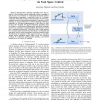Free Online Productivity Tools
i2Speak
i2Symbol
i2OCR
iTex2Img
iWeb2Print
iWeb2Shot
i2Type
iPdf2Split
iPdf2Merge
i2Bopomofo
i2Arabic
i2Style
i2Image
i2PDF
iLatex2Rtf
Sci2ools
IROS
2008
IEEE
2008
IEEE
High-dimensional underactuated motion planning via task space control
Abstract— Kinodynamic planning algorithms have the potential to find feasible control trajectories which accomplish a task even in very nonlinear or constrained dynamical systems. Underactuation represents a particular form of a dynamic constraint, inherently present in many machines of interest (e.g., walking robots), and necessitates planning for long-term control solutions. A major limitation in motion planning techniques, especially for real-time implementation, is that they are only practical for relatively low degree-of-freedom problems. Here we present a model-based dimensionality reduction technique based on an extension of partial feedback linearization control into a task-space framework. This allows one to plan motions for a complex underactuated robot directly in a low-dimensional task-space, and to resolve redundancy with lower-priority tasks. We illustrate the potential of this approach with an extremely simple motion planning system which solves the swing-up problem f...
Feasible Control Trajectories | IROS 2008 | Kinodynamic Planning Algorithms | Motion Planning | Robotics |
| Added | 31 May 2010 |
| Updated | 31 May 2010 |
| Type | Conference |
| Year | 2008 |
| Where | IROS |
| Authors | Alexander C. Shkolnik, Russ Tedrake |
Comments (0)

